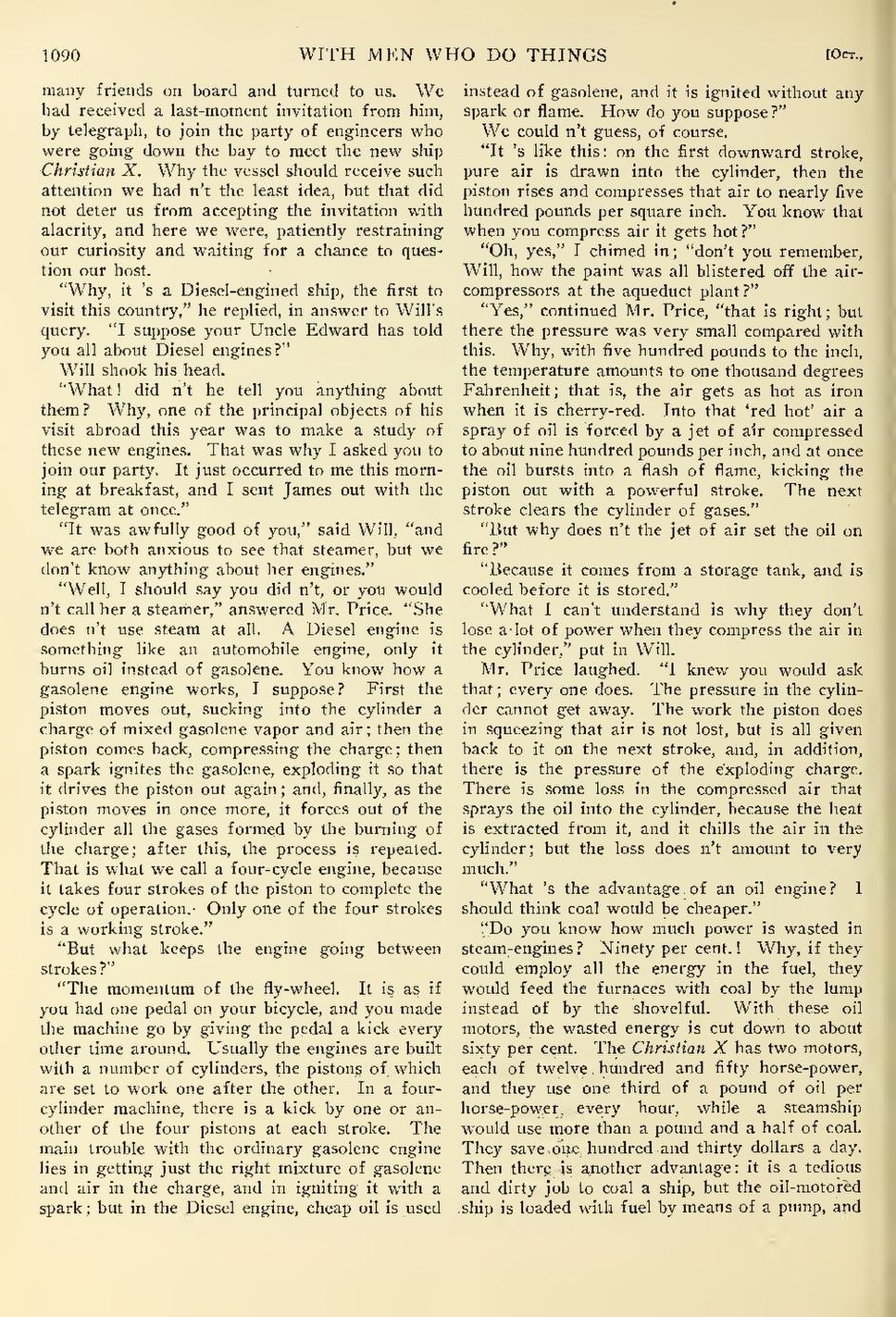“Why, it’s a Diesel-engined ship, the first to visit this country,” he replied, in answer to Will's query. “I suppose your Uncle Edward has told you all about Diesel engines?"
Will shook his head.
“What! did n't he tell you anything about them? Why, one of the principal objects of his visit abroad this year was to make a study of these new engines. That was why I asked you to join our party. It just occurred to me this morning at breakfast, and I sent James out with the telegram at once.”
“It was awfully good of you,” said Will, “and we are both anxious to see that steamer, but we don't know anything about her engines.”
“Well, I should say you did n't, or you would n’t call her a steamer,” answered Mr. Price. “She does n't use steam at all, A Diesel engine is something like an automobile engine, only it burns oi] instead of gasolene. You know how a gasolene engine works, I suppose? First the piston moves out, sucking into the cylinder a charge of mixed gasolene vapor and air; then the piston comes hack, compressing the charge; then a spark ignites the gasolene, exploding it so that it drives the piston out again; and, finally, as the piston moves in once more, it forces out of the cylinder all the gases formed by the burning of the charge; after this, the process is repeated. That is what we call a four-cycle engine, because it takes four strokes of the piston to complete the cycle of operation.. Only one of the four strokes is a working stroke.”
“But what keeps the engine going between strokes?”
“The momentum of the fly-wheel. It is as if you had one pedal on your bicycle, and you made the machine go by giving the pedal a kick every other time around, Usually the engines are built with a number of cylinders, the pistons of which are set to work one after the other, In a four-cylinder machine, there is a kick by one or another of the four pistons at each stroke, The main trouble with the ordinary gasolene engine lies in getting just the right mixture of gasolene and air in the charge, and in igniting it with a spark; but in the Diesel engine, cheap oil is used instead of gasolene, and it is ignited without any spark or flame. How do you suppose?”
We could n’t guess, of course,
“It ’s like this: on the first downward stroke, pure air is drawn into the cylinder, then the piston rises and compresses that air to nearly five hundred pounds per square inch. You know that when you compress air it gets hot?”
“Oh, yes,” I chimed in; “don’t you remember, Will, how the paint was all blistered off the air-compressors at the aqueduct plant?”
“Yes,” continued Mr. Price, “that is right; but there the pressure was very small compared with this. Why, with five hundred pounds to the inch, the temperature amounts to one thousand degrees Fahrenheit; that is, the air gets as hot as iron when it is cherry-red. Into that ‘red hot’ air a spray of oil is forced by a jet of air compressed to about nine hundred pounds per inch, and at once the oil bursts into a flash of flame, kicking the piston out with a powerful stroke, The next stroke clears the cylinder of gases.”
“But why does n’t the jet of air set the oil on fire?”
“Because it comes from a storage tank, and is cooled before it is stored.”
“What I can't understand is why they don’t lose a lot of power when they compress the air in the cylinder,” put in Will.
Mr, Price laughed. “1 knew you would ask that; every one does. The pressure in the cylinder cannot get away. The work the piston does in squeezing that air is not lost, but is all given back to it on the next stroke, and, in addition, there is the pressure of the exploding charge. There is some loss in the compressed air that sprays the oil into the cylinder, because the heat is extracted from it, and it chills the air in the cylinder; but the loss does n’t amount to very much.”
“What ’s the advantage of an oil engine? I should think coal would be cheaper.”
“Do you know how much power is wasted in steam-engines? Ninety per cent.! Why, if they could employ all the energy in the fuel, they would feed the furnaces with coal by the lump instead of by the shovelful. With these oil motors, the wasted energy is cut down to about sixty per cent. The Christian X has two motors, each of twelve. hundred and fifty horse-power, and they use one third of a pound of oil per horse-power, every hour, while a steamship would use more than a pound and a half of coal. They save one hundred and thirty dollars a day. Then there is another advantage: it is a tedious and dirty job to coal a ship, but the oil-motored ship is loaded with fuel by means of a pump, and